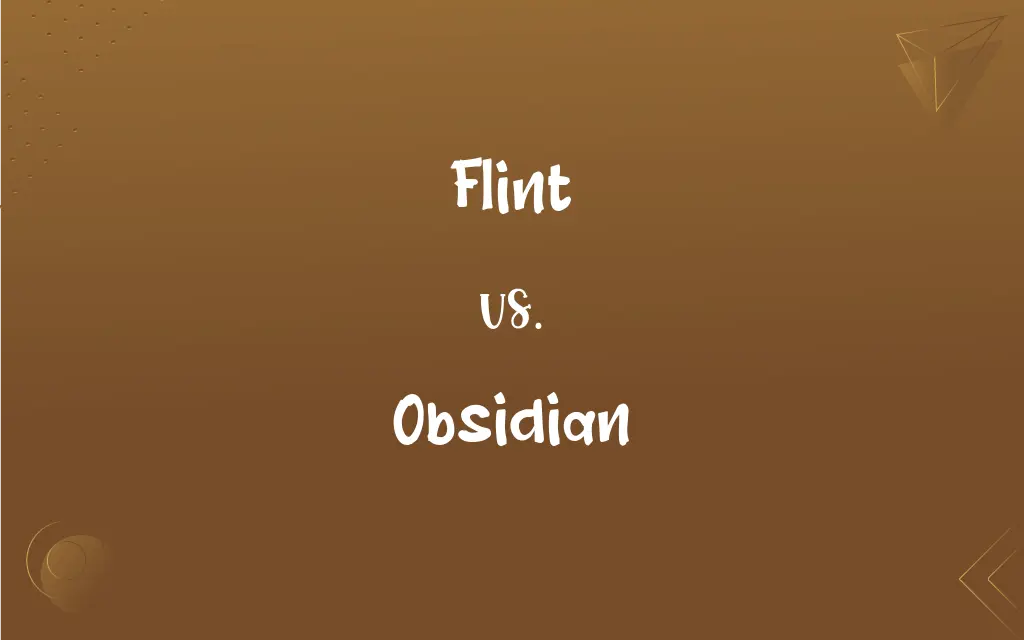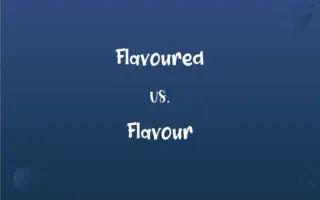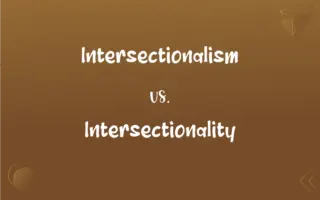Flint vs. Obsidian: What's the Difference?
By Janet White & Harlon Moss || Updated on May 22, 2024
Flint is a hard, sedimentary cryptocrystalline form of quartz, used for tool-making and fire-starting. Obsidian is a naturally occurring volcanic glass formed from rapid cooling of lava, prized for its sharp edges and historical use in tools and weapons.

Key Differences
Flint is a type of hard, sedimentary rock primarily composed of silica (quartz). It forms in chalk or limestone and has a smooth, glassy appearance. Historically, flint was widely used in tool-making and as a fire-starting material due to its ability to create sparks when struck against steel. Obsidian, on the other hand, is a natural volcanic glass formed when lava cools rapidly without crystal growth. It is typically dark and has a shiny, glass-like surface. Obsidian is known for its sharp edges when fractured, making it a valuable material for cutting tools and weapons throughout history.
Flint is found in sedimentary rocks such as chalk and limestone, often appearing as nodules or layers. It has been used since prehistoric times to create tools like knives, scrapers, and arrowheads, due to its durability and ability to be flaked into sharp edges. Obsidian forms in volcanic environments, where rapid cooling of lava prevents the formation of crystals, resulting in a smooth, glassy texture. It was used by ancient civilizations to make sharp blades and arrowheads. Its sharpness is due to the conchoidal fracture pattern it follows when broken.
While flint was more commonly used in regions with sedimentary rock deposits, obsidian was favored in areas with volcanic activity. Both materials were crucial in early human technology but were sourced from different geological environments.
Flint and obsidian also differ in appearance and physical properties. Flint usually appears in various shades of gray, brown, or black and has a dull luster. Obsidian is typically black or dark green and has a vitreous (glassy) luster. The main difference lies in their formation process and the sharpness of the edges they can produce.
Comparison Chart
Composition
Sedimentary cryptocrystalline quartz
Volcanic glass
ADVERTISEMENT
Formation
Found in chalk or limestone deposits
Formed from rapidly cooled lava
Appearance
Gray, brown, black; dull luster
Black, dark green; glassy luster
Historical Use
Tool-making, fire-starting
Cutting tools, weapons
Fracture Pattern
Conchoidal
Conchoidal
Sharpness
Sharp, but less than obsidian
Extremely sharp edges
ADVERTISEMENT
Geological Source
Sedimentary rocks
Volcanic regions
Common Forms
Nodules, layers
Large glassy masses
Flint and Obsidian Definitions
Flint
A hard, sedimentary form of quartz used in tools and fire-starting.
Early humans used flint to make cutting tools and weapons.
Obsidian
A naturally occurring volcanic glass with sharp edges.
The ancient blades were crafted from obsidian for their sharpness.
Flint
A material that creates sparks when struck.
Campers often use flint to start fires in the wilderness.
Obsidian
Used by ancient civilizations for tools and weapons.
Obsidian arrowheads were highly effective in hunting.
Flint
Found in chalk and limestone deposits.
The archaeologists discovered flint nodules in the ancient site.
Obsidian
Typically dark in color, often black or dark green.
The volcanic eruption left behind large deposits of obsidian.
Flint
A very hard, fine-grained quartz that sparks when struck with steel.
Obsidian
Formed from rapid cooling of lava.
Obsidian is found near volcanic regions.
Flint
A piece of flint used to produce a spark.
Obsidian
Known for its glassy texture and conchoidal fracture.
The black obsidian shone with a vitreous luster.
Flint
A small solid cylinder of a spark-producing alloy, used in lighters to ignite the fuel.
Obsidian
A usually black or banded, hard volcanic glass that displays shiny, curved surfaces when fractured and is formed by rapid cooling of lava.
Flint
A piece of flint used as a tool by prehistoric humans.
Obsidian
(mineral) A type of naturally occurring black glass produced by volcanoes.
Flint
Something resembling flint in hardness
A jaw of flint.
Obsidian
A slightly bluish black, the color of obsidian glass.
Flint
A hard, fine-grained quartz that fractures conchoidally and generates sparks when struck against a material such as steel, because tiny chips of the steel are heated to incandescence and burn in air.
He used flint to make a fire.
Obsidian
(poetic) black
Flint
A piece of flint, such as a gunflint, used to produce a spark by striking it with a firestriker.
Obsidian
A kind of glass produced by volcanoes. It is usually of a black color, and opaque, except in thin splinters.
Flint
A small cylinder of some other material of the same function in a cigarette lighter, etc.
Obsidian
Acid or granitic glass; usually dark, but transparent in thin pieces
Flint
A type of maize/corn with a hard outer hull.
Flint
(figurative) Anything figuratively hard.
Flint
(transitive) To furnish or decorate an object with flint.
Flint
A massive, somewhat impure variety of quartz, in color usually of a gray to brown or nearly black, breaking with a conchoidal fracture and sharp edge. It is very hard, and strikes fire with steel.
Flint
A piece of flint for striking fire; - formerly much used, esp. in the hammers of gun locks.
Flint
Anything extremely hard, unimpressible, and unyielding, like flint.
Flint
A hard kind of stone; a form of silica more opaque than chalcedony
Flint
A river in western Georgia that flows generally south to join the Chattahoochee River at the Florida border where they form the Apalachicola River
Flint
A city in southeast central Michigan near Detroit; automobile manufacturing
Flint
A rock that fractures to produce sharp edges.
He struck the flint against steel to create sparks.
Flint
Used historically for its durability and workability.
Flint knives were essential for survival in prehistoric times.
FAQs
How does obsidian form?
Obsidian forms when lava cools rapidly without crystal growth, resulting in a glassy texture.
What is flint?
Flint is a hard, sedimentary cryptocrystalline form of quartz used historically for tools and fire-starting.
What are the main uses of flint?
Flint was historically used for making cutting tools, weapons, and fire-starting implements.
What is obsidian?
Obsidian is a natural volcanic glass formed from rapidly cooled lava, known for its sharp edges.
How does flint form?
Flint forms in chalk or limestone deposits, often as nodules or layers.
What type of fracture does flint have?
Flint has a conchoidal fracture, allowing it to be shaped into sharp tools.
What are the main uses of obsidian?
Obsidian was used for making sharp blades, tools, and weapons due to its ability to fracture into very sharp edges.
What are the physical characteristics of flint?
Flint typically appears in shades of gray, brown, or black with a dull luster.
Which has sharper edges, flint or obsidian?
Obsidian has sharper edges than flint due to its glassy nature and conchoidal fracture pattern.
Can flint produce sparks?
Yes, flint can produce sparks when struck against steel, making it useful for fire-starting.
Are there modern uses for flint?
Flint is still used in some survival kits for fire-starting and in certain traditional crafts.
Are there modern uses for obsidian?
Obsidian is used in some surgical tools for its sharpness and is popular in jewelry and decorative items.
What are the physical characteristics of obsidian?
Obsidian is usually black or dark green with a glassy luster.
What type of fracture does obsidian have?
Obsidian also has a conchoidal fracture, which enables it to be fashioned into extremely sharp edges.
Which material was used more in ancient tool-making?
Both materials were used, but the choice depended on the geographical availability; flint was more common in sedimentary regions, while obsidian was used in volcanic areas.
What is the appearance of flint?
Flint is usually dull and opaque with colors ranging from gray to brown to black.
Where is obsidian commonly found?
Obsidian is commonly found in volcanic regions where lava has cooled rapidly.
Where is flint commonly found?
Flint is commonly found in sedimentary rocks, such as chalk and limestone.
Is obsidian harder than flint?
No, flint and obsidian have similar hardness, but obsidian is generally considered more brittle.
What is the appearance of obsidian?
Obsidian is typically shiny, glassy, and can be black, dark green, or even have a rainbow sheen in certain varieties.
About Author
Written by
Janet WhiteJanet White has been an esteemed writer and blogger for Difference Wiki. Holding a Master's degree in Science and Medical Journalism from the prestigious Boston University, she has consistently demonstrated her expertise and passion for her field. When she's not immersed in her work, Janet relishes her time exercising, delving into a good book, and cherishing moments with friends and family.
Co-written by
Harlon MossHarlon is a seasoned quality moderator and accomplished content writer for Difference Wiki. An alumnus of the prestigious University of California, he earned his degree in Computer Science. Leveraging his academic background, Harlon brings a meticulous and informed perspective to his work, ensuring content accuracy and excellence.































































